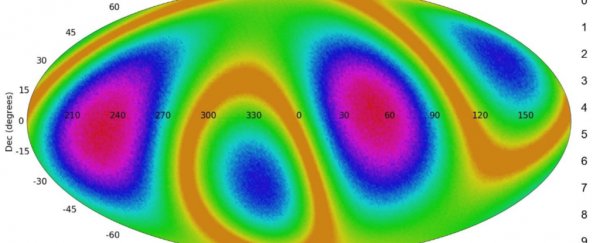The Universe is not a structureless mish-mash of space stuff, but there's still a lot we don't know about how it's put together.
Although we know that everything is connected by a vast, filamentary web, we tend to operate under the assumption that the distribution of galaxies among those filaments is somewhat random.
In other words, if you pick a patch of sky, scientists generally think that the spin directions of all the galaxies in that patch will be more or less evenly distributed.
Well, it turns out that that assumption may be incorrect.
Computational astronomer Lior Shamir of Kansas State University has conducted a survey of 200,000 galaxies, and found that the distribution of spin direction forms a pattern that is distinctly not random after all.
In fact, that pattern can be fitted to a quadrupole alignment with a much higher probability than chance - suggesting that the early Universe as a whole could have been spinning like a giant galaxy.
Shamir presented his paper, which is yet to be peer-reviewed, at the 236th meeting of the American Astronomical Society.
" Cosmic Microwave Background (CMB) data also shows evidence of possible cosmological-scale polarisation, and was fitted to quadrupole alignment. These observations led to theories that shift from the standard cosmological models," Shamir writes in his paper.
"Since the spin patterns of a galaxy as visible from Earth is also an indication of the actual spin direction of the galaxy, the large-scale patterns in the distribution of the spin directions can be an indication of a rotating Universe."
Spiral galaxies are relatively tidy and well-defined, with a flat disc shape, spiral arms, and rotation that we can measure based on the Doppler shift of light from the sides of the disc.
Blueshifted light is made up of shorter wavelengths, and indicates rotation towards us; redshifted light is made up of longer wavelengths, and indicates rotation away from us.
There are only two directions these galaxies can spin - clockwise and counterclockwise. If the Universe is isotropic, or uniform in all directions, as described by the cosmological principle, there should be a pretty even 50-50 distribution of clockwise and counterclockwise galaxies throughout.
But when Shamir conducted his census using data obtained from the Sloan Digital Sky Survey (SDSS) and the Panoramic Survey Telescope and Rapid Response System (Pan-STARRS), he found something very peculiar.
The split identified was closer to 51-49, with more clockwise galaxies than counterclockwise. That may seem like a small difference, but according to Shamir, the chance of such asymmetry in an isotropic Universe is at least one in 1 billion.
 An all-sky mollweide map of the quadrupole in the distribution of galaxy spin directions. (Kansas State University)
An all-sky mollweide map of the quadrupole in the distribution of galaxy spin directions. (Kansas State University)
He also found that the asymmetry itself is not uniformly distributed. Closer to Earth, the gap closes, and the distribution of galaxies is more even - but farther out in the Universe, the asymmetry is more pronounced.
Shamir believes these findings could suggest that the early Universe was less chaotic than it is today, and that its consistency is decreasing over time.
The differences in the asymmetry across different parts of the Universe are consistent with a quadrupole pattern - that is, the Universe wasn't rotating around a single axis, but four axes in a complex alignment.
The quadrupole found in the cosmic microwave background - the faint radiation left over from the Big Bang that suffuses the Universe - has been referred to as an "anomaly", a "problem" and the "Axis of Evil".
Because the cosmic microwave background is so faint, it's possible that the signal has been contaminated by the much brighter light of the current Universe.
However, the spin of galaxies is pretty easy to measure, so Shamir's research suggests that the cosmic microwave background quadrupole anomaly might be an even thornier problem than cosmologists thought.
"There is no error or contamination that could exhibit itself through such unique, complex, and consistent patterns," Shamir says.
"We have two different sky surveys showing the exact same patterns, even when the galaxies are completely different. There is no error that can lead to that. This is the Universe that we live in. This is our home."
The research is available on the pre-print website arXiv.org.
